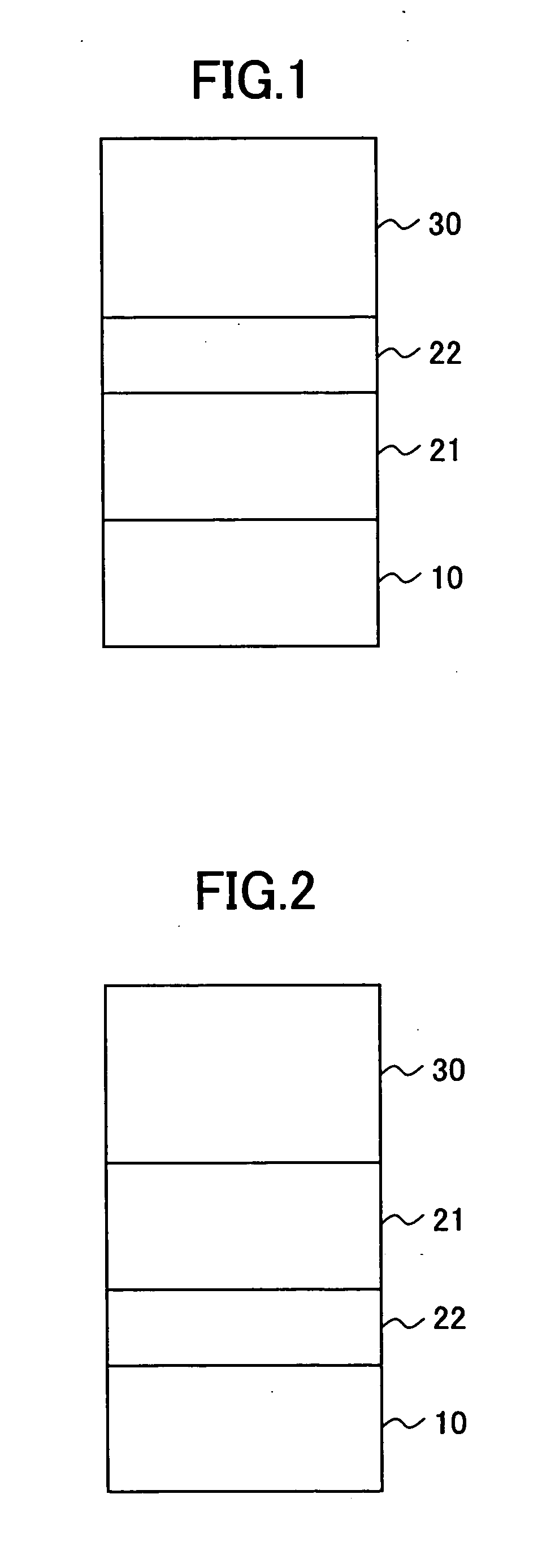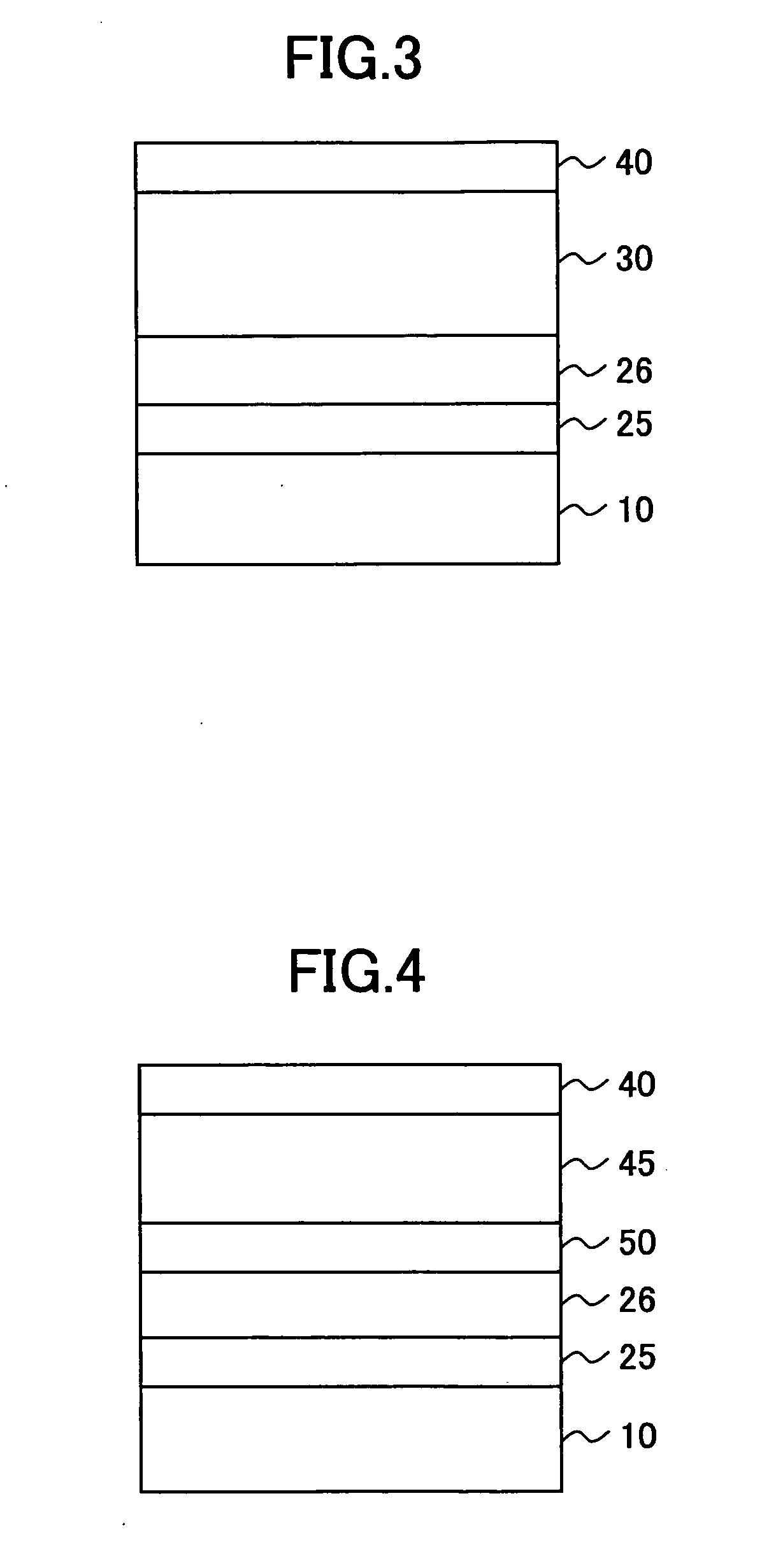Particularly, in the case of performing full-
color printing, the speeding up and the
miniaturization of the apparatuses are further important problems since overlapping of toner images with at
laser four colors is required.
However, with the progression of the reduction in the
diameter of the photoconductor, the exchange frequency of a conventional photoconductor becomes much frequent, which is further serious problem, particularly, in a high-speed
machine, since the photoconductor is be used in a severe condition.
However, there is
anxiety such that background
contamination significantly occurs in the photoconductor using titanyl
phthalocyanine because of the deterioration of charging caused by aggregation or fatigue of the pigment.
Thus, the background
contamination is a large factor for determining the life of a photoconductor, and since the speeding up of the apparatus can be attained by the photoconductor using titanyl
phthalocyanine but the influence of background
contamination becomes larger,
image quality stability is poor and the satisfaction of both the speeding up and the attainment of high durability has not been realized.
Therefore, in regard to the conventional photoconductor using titanyl
phthalocyanine, the exchange frequency of the photoconductor is significantly large and providing stable mages over a long term has not been realized, as it is used in a high-speed
machine.
Particularly, as the
electrical field strength elevates by the decrease of the film thickness, the generation of background contamination significantly increases.
Thus, in order to realize the speeding up,
miniaturization, and long life of an image formation apparatus, it is apparent that the attainment of high sensitivity, small
diameter, and high durability of an electrophotographic photoconductor used therein are needed, but the major problem on realizing them is the suppression of background contamination as mentioned above.
However, since the electric resistances of these single-layered and singularly resinous intermediate
layers are high, the elevation of a residual electric potential is caused and the lowering of image concentration or the deterioration of a
gradation characteristic is caused in negative or positive development.
Therefore, it is necessary to make the intermediate layer be a thin film and the actual situation is that the sufficient suppression of background contamination has not been realized.
However, in a single one of these resinous intermediate layers, the tendency that the background contamination increases is found even though the reduction of a residual electric potential is realized, and there are problems that interference fringes of light appear on an image and Moire image generates, in a recent image formation apparatus using coherent light such as
laser light.
Although such an intermediate layer in which filers are dispersed is effective for the suppression of Moire, it is necessary to increase the filler content for reducing the residual electric potential and it is preferable to reduce the quantity of the filler for suppressing the background contamination, but balancing of the background contamination and the residual electric potential has not been achieved yet.
Further, as the content of the resin becomes lower, the adhesion property with the
electrically conductive support lowers and the problem arises that peeling between the support and the intermediate layer is easy to occur, and thus there are many problems for the attainment of high durability of the photoconductor.
However, it is difficult to sufficiently suppress the influence of background contamination by only stacking the
electrically conductive layer and an intermediate layer.
Particularly, as the
electric field strength increases with the progression of photoconductor wearing, the background contamination significantly increases and the enhancement of a charge blocking function of the underlying layer or intermediate layer also under high
electric field strength causes remarkable elevation of the residual electric potential, and, therefore, the suppression effect to the background contamination in repeated use of the photoconductor is not sufficient by only suppressing the
charge injection from the electrically conductive support by means of the underlying layer or the intermediate layer and the high durability of the photoconductor has not been realized yet.
Furthermore, when
coating is applied on the underlying layer, it is necessary to be insoluble to
solvent thereof, and a defect of the
coating film influences the background contamination, and, therefore, high quality of
coating film and high coating property such that the deviation of film thickness is small even in a thin film are required.
Moreover, the cause of background contamination is not only charge (hole) injection from an electrically conductive support to a photoconductive layer but also cannot ignore the influence on the photoconductor as mentioned above.
Also, since the purity of titanyl phthalocyanine has a large influence, the charging deterioration is significantly caused by the containment of impurities and the increase of dark decay is caused by fatigue, whereby the resistance to the background contamination is significantly deteriorated.
Thus, in the conventional techniques, the elevation of a residual electric potential or the environmental dependence increases significantly as the background contamination is suppressed, while the background contamination suppression effect becomes insufficient as the elevation of a residual electric potential is suppressed, etc., the balancing therebetween has not been realized.
However, among these techniques, (i) the use of a curable binder has a tendency of facilitating to elevate the residual electric potential and to cause the lowering of image concentration by impurities such as a
polymerization initiator and an unreacted residue.
Also, (ii) the use of a polymeric charge transportation material can improve the
wear resistance to some extent, but has not led to sufficiently satisfy the durability required for an
organic photoconductor.
Also, in regard to the polymeric charge transportation material, since the
polymerization and purification of the material are difficult and it is difficult to obtain high purity, the electric characteristics of the material is difficult to be stable.
Furthermore, a problem on manufacture such that coating liquid becomes highly viscous may occur.
Also, when the irregularities made of
inorganic filler and a binder resin on a photoconductor surface is large, improper cleaning occurs, which may cause toner filming or image deletion.
These techniques (i), (ii), and (iii) may be effective for the suppression of background contamination but have a
disadvantage on a residual electric potential, a cleaning property, etc., and has not led to satisfying the durability sufficiently because of the influence of an image defect caused by it.
However, in regard to this photoconductor, there is a description of the meaning of containing this substance obtained by curing multi-functional
acrylate monomers in a
protection layer provided on a photoconductive layer but there is an only description that a charge transportation material may be contained in this
protection layer and no specific description, and further in the case of simply containing low-molecular-weight charge transportation material in a crosslinked-type charge transportation layer, there is a problem of compatibility with the aforementioned cured substance, whereby the
precipitation or white
turbidity phenomenon of a low-molecular-weight charge transportation material occurs and not only image concentration lowered by the elevation of an electrical potential of exposed portion but also the
mechanical strength might lower.
Furthermore, since, specifically, the monomers are reacted on the condition of containing a polymeric binder in regard to this photoconductor, three-dimensional
network structure develops insufficiently and the crosslink density thereof is subtle, thereby having not led to be able to exert a drastic
wear resistance.
Although this photoconductor satisfies both a
wear resistance and a good electrical characteristic and draws attention, the compatibility of a binder resin and a cured substance produced by the reaction of the aforementioned
monomer and the charge transportation material is low and layer peeling occurs in a crosslinked-type charge transportation layer, thereby causing damage or the fixation of an external additive and paper
powder in toner, in the case of using one having no reactivity as the binder resin.
Also, as mentioned above, three-dimensional
network structure develops insufficiently and the crosslink density thereof is subtle, thereby having not led to exert a drastic wear resistance.
In addition, the specifically described monomer used in this photoconductor is two-functional and the wear resistance thereof has not led to satisfaction yet in these respects.
Also, in the case of using a binder resin having reactivity, the molecular weight of the cured substance increases but the number of intermolecular crosslinkages is low, and it is difficult to satisfy both the bonding quantity and the crosslink density of the aforementioned charge transportation material and the electrical characteristic and the wear resistance were insufficient.
Although the crosslink density of this photoconductive layer can be high, it has a high
hardness, but
distortion occurs in a cured substance and the
internal stress thereof becomes large since a bulky hole transportation compound has two or more chain-polymerizable functional groups, whereby a crack or peeling in the cross-linked
surface layer may be easy to occur in use over a long term.
It is considered that the photoconductor having a crosslinked photoconductive layer for which charge transporting structures are chemically bonded in these conventional techniques has no sufficient overall characteristics in the present circumstances.
Thus, while many conventional techniques for enhancing the wear resistance of a photoconductor are disclosed and it is known that they are effective for the suppression of background contamination, the generation of an image defect such as the deterioration of resolution or
gradation, image deletion, and the adhesion of foreign substances is induced even if the background contamination can be suppressed, that is, the elevation of a residual electric potential becomes easy to occur, image deletion becomes easy to be caused dependent on
humidity, a photoconductor surface becomes difficult to be refaced whereby filming becomes easy to occur, etc., and the stability of image quality is greatly deteriorated, and, therefore, in fact, the attainment of high durability of a photoconductor has not been realized.
Also, only enhancing the wear resistance of a photoconductor can reduce the influence to
electric field with time but the influence caused by
charge injection from an electrically conductive support is facilitated by the deterioration of charging caused by the fatigue of the photoconductor, and, therefore, the effect is not sufficient.
However, the satisfaction of all of them has not been realized in the conventional techniques and the actual circumstance is that the high durability of a photoconductor has not been achieved yet.
 Login to View More
Login to View More  Login to View More
Login to View More 


